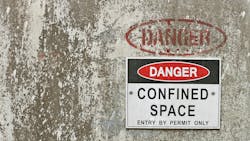A confined entry permit may address a simple situation in which realistically nothing can go wrong. For example, you’re replacing a lift control in a garage pit during regular working hours. There are plenty of people around, and anyone in the pit is readily visible. The only reason for the confined entry permit is the ventilation fan is on the same circuit as the lift and that circuit is under lockout/tagout (LOTO) so you can replace the switch and thus it is possible for exhaust gas from the one car at the other end of the garage to fill that pit while you are in there.
A confined entry permit is typically for a more complex situation in which many possibilities exist for problems to arise. The key to ensuring you can exit a confined entry space on your own power is to resolve problems with safety as your main concern, rather than making convenience or efficiency your main concern.
So when faced with a problem related to a confined space, always apply the “safety first” filter to any solutions. Doing so can result in extreme inconvenience and high inefficiency, but either of those outcomes is superior to being rescued only after suffering permanent brain damage from lack of oxygen — and dying is not so great an outcome, either.
Let’s consider a process chamber that has difficult access and limited room inside. Suppose the confined entry permit requires frequently taking O2 readings, but halfway through the job, you inadvertently damage your O2 meter, and it doesn’t work.
Compared to crawling back out, it would be more convenient to just proceed with the failed gas meter if the O2 was fine upon entry. But someone determined the correct interval for measuring the O2, and that determination was made based on what’s known about that particular confined space. Maybe you could holler out to the attendant to get you another one. The attendant can pass another one to you, if he has one available for that purpose. If not, you’ll have to exit the chamber.
For example, what happens if you need to add Gary as a crew member because you ran into a technical problem that Gary has the expertise to solve and you don’t? Or you just need another pair of hands? How does Gary join you on the job?
The convenient answer is Gary enters using your confined entry permit. The safe answer is Gary obtains his own confined entry permit. Being added to someone else’s confined entry permit is convenient, but it leaves you unprepared to safely enter and work in that space.
When Gary obtains his own confined entry permit, he goes through it with the relevant supervisor. That process has him questioning what he doesn’t understand, getting instructions on how long he can be in there, getting set up with extraction gear, and so forth. If this were a large confined space, Gary would also get instruction on which parts of this space he can access. In either case, he would also be informed of additional hazards inside that space.
Typically, the solution to a confined entry problem will be inconvenient. But there’s no free lunch here, a solution that compromises safety is no solution at all. No matter how rushed you are or what a royal pain the safe solution is, the safe solution is the only correct one.
About the Author

Mark Lamendola
Mark is an expert in maintenance management, having racked up an impressive track record during his time working in the field. He also has extensive knowledge of, and practical expertise with, the National Electrical Code (NEC). Through his consulting business, he provides articles and training materials on electrical topics, specializing in making difficult subjects easy to understand and focusing on the practical aspects of electrical work.
Prior to starting his own business, Mark served as the Technical Editor on EC&M for six years, worked three years in nuclear maintenance, six years as a contract project engineer/project manager, three years as a systems engineer, and three years in plant maintenance management.
Mark earned an AAS degree from Rock Valley College, a BSEET from Columbia Pacific University, and an MBA from Lake Erie College. He’s also completed several related certifications over the years and even was formerly licensed as a Master Electrician. He is a Senior Member of the IEEE and past Chairman of the Kansas City Chapters of both the IEEE and the IEEE Computer Society. Mark also served as the program director for, a board member of, and webmaster of, the Midwest Chapter of the 7x24 Exchange. He has also held memberships with the following organizations: NETA, NFPA, International Association of Webmasters, and Institute of Certified Professional Managers.
